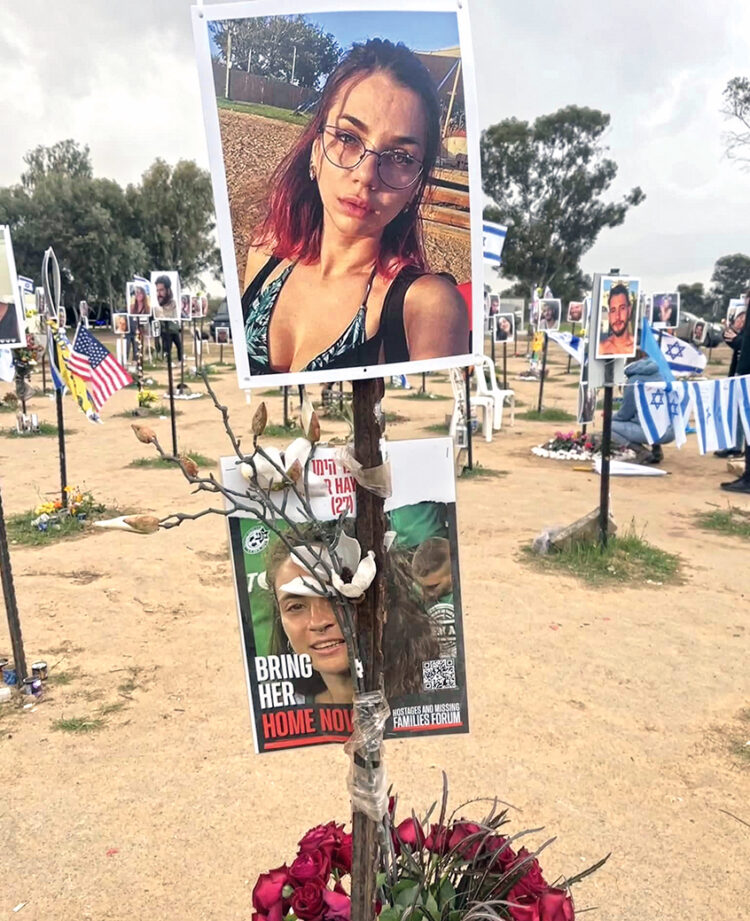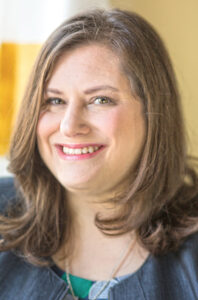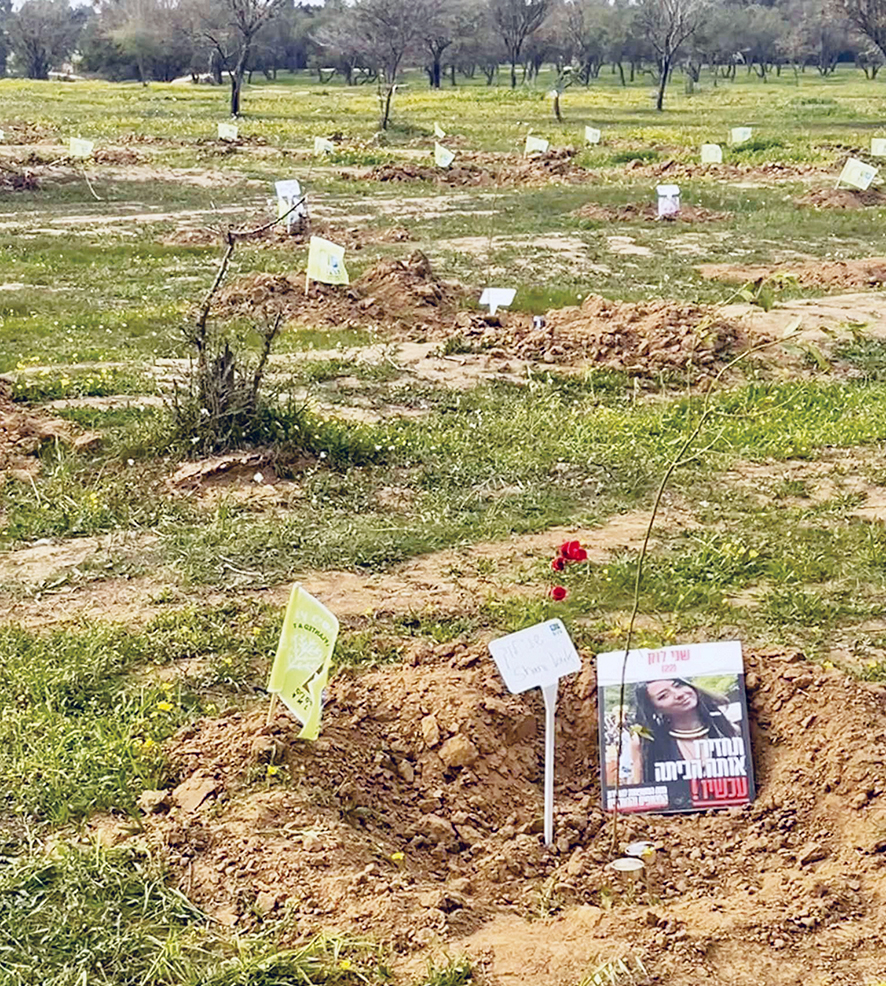Through the valley of deepest darkness

Story and Photos by Rabbi Karen Bodney-Halasz, Temple Israel
The Talmud teaches that visiting the infirm relieves 1/60th of their pain. It is integral to their healing process. Offering comfort from mental and physical suffering is part of our responsibility as Jews.
Going on a mission trip to Israel Jan. 22-25 was my way of fulfilling that duty, of saying: “You are not alone. I’m with you.” It was also a shiva call.
We were seven rabbis (five Reform, two Conservative) from the Midwest.
With my colleagues, I returned to Kibbutz Kfar Aza, where I had been almost a year ago to the day.
I thought I was prepared for what I would see there, having watched many videos, heard from our kibbutz tour guide via Zoom after the attack, and already having seen pictures.
But I don’t think anything can prepare a person to see that level of destruction. I was personally relieved that enough time had passed that I did not smell the stench of burnt and decaying flesh that many who had visited have written about.

Kibbutz Kfar Aza is nearly two miles from the Gaza border. When we visited last year, many Temple Israel congregants found it a beautiful, idyllic home where they could easily see themselves living.
The ground was lush, the flowers were beautiful, and the homes were well kept.
Everyone knew each other and looked out for each other. There were bicycles all around, and children out playing together in the courtyard areas.
My son Jonah kept looking longingly out at the children playing soccer on the lawn, likely wishing he was playing with them instead of learning about incendiary balloons and bomb shelters with us.
Many members of this kibbutz were involved in efforts toward making peace with their neighbors in Gaza.
Every year, Kfar Aza holds a kite festival for peace. They create colorful, joyful kites and, as a community, send them toward Gaza with messages of peace.
This event began as a response to the Gazan population sending incendiary kites to Kfar Aza to set Israeli homes and fields on fire.
Gazans also sent balloons filled with explosives intended to detonate when children approached them.
Oct. 7 is the day of the annual kite festival. Instead of flying kites that day, the person who planned the festival was found murdered, with his arms wrapped around his family. His kites were there, too.
When I entered the kibbutz this time, I was greeted by Lir, a 27-year-old lifelong resident of Kfar Aza who survived the Oct. 7 attacks. Our group was one of many there that day, as well as some reporters.
Lir trains therapy dogs. She said she was glad her dogs were not outside with her that morning; Hamas killed most of the dogs they saw.
Lir woke up the morning of Oct. 7 when she heard rockets. At 6:30 a.m., she went outside to look. She sensed something big was going on. She saw five paragliders and 10 terrorists from the Nuchba elite combat unit of Hamas.
The Nuchba fighters came first and took out Kfar Aza’s gate. By 9:30 a.m., the second wave of terrorists had infiltrated. The gate and path became a nonstop road for Hamas and Palestinians between Gaza and the kibbutz.
Lir immediately went into her saferoom when she saw what was happening and connected with other kibbutz members through WhatsApp.
That morning, the kibbutz had been attacked from four directions. The first line of defense Hamas took out was Kfar Aza’s volunteer emergency squad.
The IDF did not arrive until 12 hours later. During that time, Hamas murdered 63 members of the kibbutz and took 16 as hostages into Gaza.
At least 10 more kibbutznikim are still in hospitals, injured. As she showed us the newly replaced gate, Lir spoke about one of the young women taken hostage who remains in Gaza.
She is a close friend of Lir. Lir is worried that her friend may be pregnant.
Women were raped on the 7th and hostages continue to be raped in captivity. Every week that passes makes that scenario harder to think about. There was deep pain in Lir’s eyes.
She openly shared that her own mental health has suffered greatly since that “Black Sabbath” of Oct. 7.
I can’t imagine the strength it must take for her to return to the scene of the crime and tell the stories of her friends and neighbors. It’s important to her on a level I would never be able to understand.

We were brought to the dor tzair area, the young generation homes. This is where young adults, newly married couples, and young families live.
The terrorists had done their research and went straight to that location. Lir told us of horrible atrocities: men and women raped, decapitated, amputated, and families bundled together and set aflame.
This only touches the surface of the cruelty she witnessed. For the sake of the families and their privacy, she wouldn’t go into more details.
There were different colored markings on the walls. These told the stories of the atrocities: the number of people who were found, how many corpses remained, a note from ZAKA to declare the space clear of bodies or body parts.
Most homes remained off limits, to guard the privacy of the families. Only one had been approved for people to enter, the home of Noar Hasidim and his partner, Sivan Elkabetz.
Inside, there were bullet holes everywhere, like Swiss cheese. Family photos memorialized the scene after they had been murdered. We saw Hebrew words saying, “human remains on the sofa.”
The young couple had been tortured for hours. The words they shared that day on WhatsApp were posted on the wall. I felt nauseated by the darkness that had befallen their home.
Many other houses in that neighborhood had memorial banners on them with the names and photos of those who had been killed or taken hostage inside.
Everywhere you looked, you faced death and destruction — burnt walls, charred roofs, blood-stained furniture strewn around.
As we passed through, Lir shared story after story about the inhabitants of the houses and their fates: near misses, deaths, kidnappings.
Over and over she said there was no logic to the day. There was no rhyme or reason to who survived and who didn’t.
One family tried to jump out of the window of their house as it burned, only to be gunned down by three terrorists waiting for them outside. Another individual did the same thing and survived.
As we turned the corner, I was surprised to run into someone I knew: Rachel Waldorf, who used to work at Goldman Union Camp Institute in Zionsville, Ind. She was also there with a mission. I think we were both glad to share a big hug.
We saw a lamppost with a bullet hole through it. That bullet had killed the mayor of the kibbutz, a strong advocate of peace.
As we completed our tour, Lir shared that she wants to return to Kfar Aza and raise a family there, but first, she needs to figure out if she will be able to sleep at night again if she returns.
Lir requested three things from us: knowledge, missions to enable survivors to share stories, and fundraising.
Knowledge: This request is to help put Lir in touch with someone who has worked with communal trauma and knows how to rebuild a community that has suffered like this.
The people who survived the Oct. 7 atrocities are deeply traumatized and will need a lot of support and care moving forward.
They need specialists and senior therapists who specialize in trauma and are able to provide the staff there with advanced tools and methods to treat the community.
Missions: The kibbutz would like to help raise the voices of survivors to testify to their pain and the depravity they experienced. They seek community leaders who will help create platforms for kibbutz members to share their personal stories with people overseas, to bring the greater community and kibbutz members together for an unmediated encounter.
Fundraising: The third request is to help with financial support to help the kibbutz rebuild. I was proud to share that Temple Israel had already made a generous donation to their cause.
As we got back into our van, we were all quiet. It was hard to say anything at all. We just needed to sit in the silence and process what we had just seen.

We drove to the site of the Nova Festival outside Kibbutz Re’im. Nova was a yearly dance party that closed out the holiday of Sukkot. It was put together by a close-knit rave community that enjoyed listening to and dancing to psytrance music. It is a very hippy-like, eco-conscious group of people who gather together at various parties over the year. Their events celebrate love and life. Neither weapons nor plastic cups are allowed. There were between 3,000 and 4,000 young people at this party.
Along the road to Re’im, there were still some blackened areas from where burnt cars had been. The festival was held near the woods with a single entrance where the security sat. When we first pulled in, we were overcome by rows and rows of freshly planted eucalyptus trees, more than 400 of them, each memorializing one of the fallen youths or hostages taken to Gaza. They had been planted by the victims’ families, together with Jewish National Fund, in honor of Tu B’Shevat, the new year of the trees. To see the country bloom again is a statement of resilience.
We were farther south from Kfar Aza, which meant we were nearer to the fighting in Gaza. Every few minutes we would hear the sound of artillery going off. Those sounds still trigger me after my experiences with the bombings in Jerusalem from when I lived there, 1995-96. We walked from the area of the newly planted trees to where the festival took place. We wandered in the drizzling rain toward an area near the trees that had been set up as a memorial, with placards on top of individual poles. Each represented a single life, all in the space where they had been dancing in the early hours.
We recited El Malei Rachamim, a Jewish memorial prayer for the dead, only for the clouds to begin raining tears upon us.
In the Mishnah, Rabbi Tarfon reminds us not to give up, especially when the task is daunting.
We must remember each of us has a role to play and we must not be discouraged from doing the work.
I pray that Israel continues to build upon its strong foundations of love and kindness, seen so abundantly since the war began.
May this endure long after this war, that we always look out for one another in difficult times and never stop dreaming of what is possible.
I still believe that peace is within reach and, as the Nova survivors remind us, we will all dance again.
Excerpted from Rabbi Karen Bodney-Halasz’s Reflections on My Mission to Israel, Jan. 22-25, 2024. To read the rabbi’s complete mission diary, go to tidayton.org.
To read the complete March 2024 Dayton Jewish Observer, click here.





